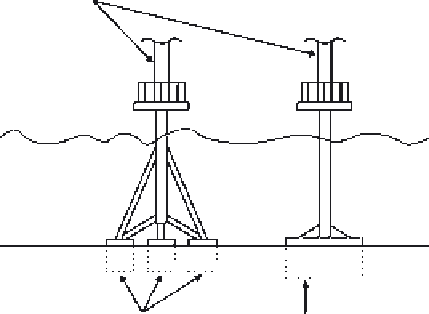Environmental Engineering Reference
In-Depth Information
5.1.1 Level-controlled suction caisson foundations
Suction caisson foundations are currently utilized in the oil and gas industry for
sea depths up to 50 m. Their installation involves transporting the suction caisson
and placing it on the seabed. Water is then pumped out of the hollow dome in the
caisson resulting in the caisson sinking into the soil and being anchored in place
as shown in Fig. 9. Large hammers are not needed and the installation process
takes hours in contrary to days with monopile. As such, this is very conducive to
assembly-line operations.
There are risks to utilize the suction caisson foundation in wind power plants.
They include:
•
Performance under lateral dynamic wind loads - Two experimental wind tur-
bines were constructed, in Denmark and England, using suction caisson foun-
dations. Results indicate that performance under long-term lateral dynamic
loads remains a key issue preventing large-scale utilization of suction caissons
in deeper sites.
Proper tower installation - Caisson verticality tolerance is not necessary in the
•
oil and gas industry. However, wind turbine tower installation requires control-
ling the foundation top surface verticality within 1°. One degree off on vertical-
ity could result in several meters of eccentricity at the hub height. It not only
results in increased over-turning moment, which is a key design criterion, but
also affects turbine performance. One EU OEM suffered an installation failure
for a near-shore test turbine because of the verticality problem from a hard spot
under one side of the caisson bottom edge during the suction process.
5.1.2 Jetting and grouting in deep sea piling
With conventional monopile foundation, heavy vessels needed for pile driving
account for 20% of the total foundation costs. Jetting and grouting eliminate the
Turbine Support Structure
Water Surface
Seabed
Caissons
Caisson
Figure 9 : Level-controlled suction caisson foundations [ 14 ].

Search WWH ::

Custom Search